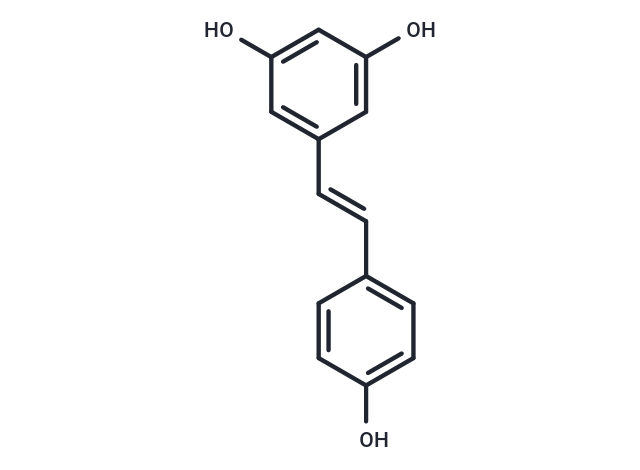Shopping Cart
- Remove All
 Your shopping cart is currently empty
Your shopping cart is currently empty

Resveratrol (SRT 501) is a polyphenolic natural product, a plant antitoxin with antioxidant and chemopreventive activities. Resveratrol has a wide range of targets including COX, SIRT, LOC, etc. Resveratrol induces autophagy and apoptosis.

| Pack Size | Price | Availability | Quantity |
|---|---|---|---|
| 100 mg | $36 | In Stock | |
| 200 mg | $50 | In Stock | |
| 500 mg | $76 | In Stock | |
| 1 mL x 10 mM (in DMSO) | $50 | In Stock |
| Description | Resveratrol (SRT 501) is a polyphenolic natural product, a plant antitoxin with antioxidant and chemopreventive activities. Resveratrol has a wide range of targets including COX, SIRT, LOC, etc. Resveratrol induces autophagy and apoptosis. |
| Targets&IC50 | COX-1:1.1 μM (cell free), COX-2:1.3 μM (cell free), DNA polymerase α:3.3 μM (cell free), DNA polymerase δ:5 μM (cell free) |
| In vitro | METHODS: Mouse mammary carcinoma cells 4T1 were treated with Resveratrol (50-250 μM) for 72 h. Cell viability was measured by CCK-8. RESULTS: Resveratrol dose-dependently inhibited the viability of 4T1 cells with an IC50 of 93 μM. [1] METHODS: Human breast cancer cells MCF-7 were treated with Resveratrol (1-100 μM) for 24 h, and the intracellular ATP content was detected by luciferin-luciferase assay. RESULTS: Resveratrol decreased the cellular ATP content. It was reduced by about 16% at 1 μM Resveratrol and 50% at 100 μM Resveratrol. [2] |
| In vivo | METHODS: To assay anti-tumor activity in vivo, Resveratrol (50-100 mg/kg, 5% ethanol and 25% polyethyleneglycol 400 in distilled water) was intraperitoneally injected into BALB/c (nu/nu) mice harboring the human ovarian teratoma PA-1 once daily for four weeks. RESULTS: Resveratrol inhibited the growth of PA-1 cell xenografts and eEF1A2 expression. [3] METHODS: To study the effects on depressed mice, Resveratrol (10-30 mg/kg) was administered intraperitoneally once daily for 21 days to C57BL/6 mice, a model of depression. RESULTS: Resveratrol significantly increased the levels of the prefrontal cortex neurotransmitters DA and 5-HT, and increased the expression of NPY in the brain, which antagonized depression. [4] |
| Cell Research | HAECs were treated with RSV in the presence of isobutylmethylxanthine (IBMX). The reaction was stopped by adding ice-cold 6% trichloroacetic acid and the supernatant fractions of the cellular lysates were extracted, dried and acetylated. Cyclic GMP levels were determined by an enzyme immunoassay kit and results standardized by protein levels [5]. |
| Animal Research | Eight-week male apoE-/- mice (C57BL/6 background) were used in the study. Mice were housed in photobiologic light-exposure chambers with a 12:12-h light:dark cycle, and eat food ad libitum. Mice were randomly divided into two groups: one group receiving a high cholesterol diet (HCD, 21% fat, 19.5% casein, and 1.5% cholesterol), the other receiving HCD supplemented with RSV (200 mg/100 g diet). All mice were fed for 8 weeks. To identify the potential role of PKA, some mice were treated with PKA specific inhibitor (KT5720, 1.2 mg/kg) via intraperitoneal injection once a day at the last 4 weeks. The animal experiments were conducted according to the institutional guidelines of Guangdong Provincial People's Hospital [5]. |
| Alias | trans-Resveratrol, SRT 501 |
| Molecular Weight | 228.24 |
| Formula | C14H12O3 |
| Cas No. | 501-36-0 |
| Smiles | C(=C/C1=CC=C(O)C=C1)\C2=CC(O)=CC(O)=C2 |
| Relative Density. | 1.359 g/cm3 |
| Storage | Powder: -20°C for 3 years | In solvent: -80°C for 1 year | Shipping with blue ice. | ||||||||||||||||||||
| Solubility Information | DMSO: 60 mg/mL (262.88 mM), Sonication is recommended. 10% DMSO+40% PEG300+5% Tween 80+45% Saline: 4.2 mg/mL (18.4 mM), In vivo: Please add the solvents sequentially, clarifying the solution as much as possible before adding the next one. Dissolve by heating and/or sonication if necessary. Working solution is recommended to be prepared and used immediately. H2O: < 1 mg/mL (insoluble or slightly soluble) Ethanol: < 1 mg/mL (insoluble or slightly soluble) | ||||||||||||||||||||
Solution Preparation Table | |||||||||||||||||||||
DMSO
| |||||||||||||||||||||

Copyright © 2015-2025 TargetMol Chemicals Inc. All Rights Reserved.